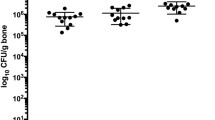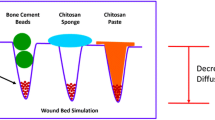Abstract
Purpose. The study objective was to evaluate the efficacy and pharmacokinetics of cefazolin delivered locally as a glyceryl monostearate (GMS) based biocompatible implant for prevention of post-operative wound infection in Sprague Dawley rats subcutaneously inoculated with Staphylococcus aureus.
Methods. For the efficacy and pharmacokinetic studies, 18 rats were subcutaneously inoculated with 4.5 x 107 CPU of S. aureus on the dorsum (6 per rat), and randomly assigned into three group of 6 rats each: (1) the control group, in which rats did not receive antibiotics, (2) the intermittent IM treatment group, in which rats received IM injections of 10 mg/kg cefazolin every 4 hr (total of 180 mg/kg in 3 days), and (3) the implant treatment group, in which rats were implanted subcutaneously with four Cefazolin-GMS implants in the vicinity of the inoculations. The implants were designed to deliver 180 mg/kg cefazolin over a 3 day period. For efficacy evaluation, the rats were euthanized one week post-inoculation and abscess count, weight and size were determined.
Results. Rats in the control group had developed 21 abscesses out of the 36 inoculations, indicating validity of the infection model. The local delivery of cefazolin resulted in complete eradication of the infection, since no abscesses formed in the rats in the implant group. In the IM treatment group, only one abscess was formed and no significant difference in efficacy between the two treatment groups was observed. The GMS implants sustained the release of cefazolin for a period of three days with only 3-fold fluctuations in plasma concentration (5.5−17.5 μg/ml). However, plasma concentrations after the intermittent IM administration of cefazolin fluctuated 110-fold between 44-0.4 μg/ml every 4 hr. The release rate of cefazolin from the implants was nearly zero order for the entire duration. Bioerosion of the implants was determined by examining the condition of the implants six weeks post-implantation. Two of the 12 implants had completely disappeared and the remaining implants were in a pasty form and had lost 20−80% of their weight. Absence of irritation or inflammation around the implants indicated biocompatibility of the GMS implants.
Conclusions. Implantable system that provided a prolonged delivery of cefazolin was found to be effective against S. aureus infection, and demonstrated suitable pharmacokinetics and biocompatibility with significant bioerosion.
Similar content being viewed by others
REFERENCES
D. S. Kernodle and A. B. Kaiser. Journal of Infectious Diseases, 168:152–157 (1993).
R. L. Nichols. In G. L. Mandell, R. G. Douglas and J. E. Bennet (eds.), Principles and Practice of Infectious Diseases, 2nd Ed., Wiley Medical, New York, 1985, pp. 1637–1643.
J. F. Burke. Journal of Annual Surgery, 158:898–904 (1963).
A. B. Kaiser. In G. L. Mandell, R. G. Douglas and J. E. Bennet (eds.), Principles and Practice of Infectious Diseases, 3rd Ed., Churchill Livingstone, New York, 1990, pp. 2245–2255.
A. G. Gilman, L. S. Goodman, T. W. Rall, and F. Murad. The Pharmacological Basics of Therapeutics, 7th Ed., Macmillan Publishing Company, New York, 1985.
Kefzol® (Eli Lilly), Physicians' Desk Reference, 44th Ed., Medical Economics Company, Inc., Oradell, 1990, pp. 1225–1227.
D. H. Livingston and M. T. Wang. The American Journal of Surgery, 165:203–207 (1993).
R. Roosendaal, I. A. J. M. Bakker-Woudenberg, J. van der Berg, and M. Michel. Journal of Infectious Diseases, 152:373–383 (1985).
B. Vogelman, S. Gudmundsson, J. Leggett, J. Turindge, S. Ebert, and W. A. Craig. Journal of Infectious Diseases, 158:831–847 (1988).
C. I. Price, J. W. Horton, and C. R. Baxter. Surgery, 115:480–487 (1994).
C. Evans, A. V. Pollock, and I. L. Rosenberg. British Journal of Surgery, 61:133–135 (1974).
M. M. Hares, M. A. Hagarty, J. Warlow, D. Malins, D. Youngs, S. Bentley, D. W. Burdon, and M. R. Keighley. British Journal of Surgery, 68:276–280 (1981).
D. R. Dirschl and F. C. Wilson. Orthopaedic Clinics of North America, 22:419–426 (1991).
A. R. Lieboff and H. S. Soroff, Archives of Surgery, 122:1005–1010 (1987).
S. Allababidi and J. Shah. Pharmaceutical Research, 12:228S (1995).
Methods for Dilution and Antimicrobial Susceptibility Tests for Bacteria that Grow Aerobically, The National Committee for Clinical Laboratory Standards, 3rd Ed., Volume 13, pp. 25 (1993).
J. G. Wagner and E. Nelson, Journal of Pharmaceutical Sciences, 53:1392–1403 (1964).
A. P. Intoccia, S. S. Walkenstein, G. Joseph, R. Wittemdorf, C. Girman, D. T. Walz, P. Actor, and J. Weisbach. Journal of Antibiotics, 31:1188–1194 (1978).
T. D. Sanford, and E. D. Colby, Laboratory Animal Science, 30:519–523 (1980).
M. F. Sullivan and D. R. Kalkwarf. NIDA Research Monograph # 4, R. Willette (ed.) pp. 27, 1976.
N. Spagnolo, F. Greco, A. Rossi, L. Ciolli, A. Teti, and P. Posteraro. Infection and Immunity, 61:5225–5230 (1993).
R. Barton and A. Moir. Pharmatherapeutica, 3:327–330 (1983).
J. H. Calhoun and J. T. Mader. The American Journal of Surgery, 157:443–449 (1989).
T. Miclau, L. E. Dahners, and R. W. Lindsey. Journal of Orthopaedic Research, 11(5):627–632 (1993).
G. Wei, Y. Kotoura, and Y. Ikada. Journal of Bone and Joint Surgery, 73-B:246–252 (1991).
C. T. Laurencin, T. Gerhart, P. Witschger, R. Satcher, A. Domb, A. E. Rosenberg, P. Hanff, L. Edsberg, W. Hayes, and R. Langer. Journal of Orthopaedic Research, 11:256–262 (1993).
D. Peri, S. Bogdansky, S. Allababidi, and J. C. Shah. Drug Development and Industrial Pharmacy, 20:1341–1352 (1994).
A. Grieben. South Africa Medical Journal, 5:395–397 (1981).
K. Adams, L. Couch, G. Cierny, J. H. Calhoun, and J. T. Mader. Clinical Orthopaedics and Related Research, 278:244–252 (1992).
J. H. Calhoun, and J. T. Mader. Clinical Orthopaedics and Related Research, 295:87–95 (1993).
U. P. Zhang, D. Pichora Wyss, and M. Goosen. Journal of Pharmaceutics and Pharmacology, 46:718–724 (1994).
Author information
Authors and Affiliations
Rights and permissions
About this article
Cite this article
Allababidi, S., Shah, J.C. Efficacy and Pharmacokinetics of Site-Specific Cefazolin Delivery Using Biodegradable Implants in the Prevention of Post-operative Wound Infections. Pharm Res 15, 325–333 (1998). https://doi.org/10.1023/A:1011939323560
Issue Date:
DOI: https://doi.org/10.1023/A:1011939323560




